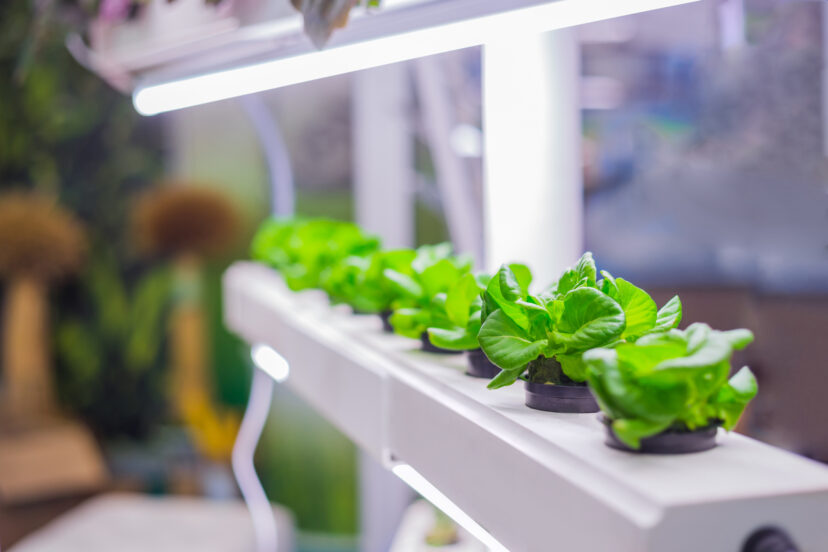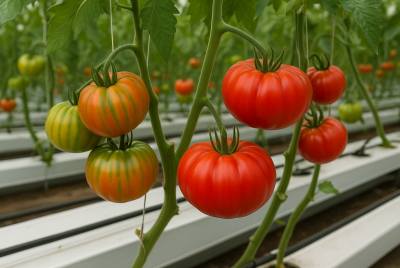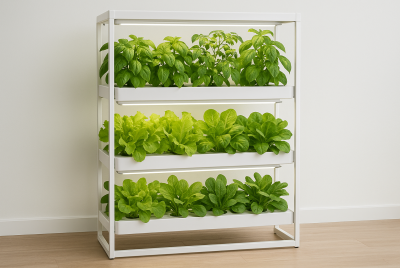Can You Start a Hydroponic Garden in a Small Apartment?
We may earn a commission for purchases made using our links. Please see our disclosure for more details.
Living in a small apartment can be challenging for gardeners because of the limited space to grow plants. You’ve probably tried using small pots on windowsills but due to lack of sunlight, your plants wilted. Also, maintaining a garden indoors can be messy and frustrating. But hey, let’s change that! A hydroponic garden will allow you to grow indoors with no mess, less effort, and efficiently. So, let’s dive into how you can turn even the tiniest living space into a thriving hydroponic haven.
What Is a Hydroponic Garden?
A hydroponic garden is a way to grow herbs, lettuce, and other plants without using soil. Instead, plants sit in nutrient-rich water solutions to get all the essentials they need to thrive. It’s a system that’s very efficient and doesn’t require too much effort (as long as the water levels are good). Plants get direct access to the best nutrients without having to work for them (or dig in dirt)—it’s a fast pass to healthy growth.
Hydroponic gardening uses less water than traditional soil-based growing, reduces the risk of pests, and eliminates the back-breaking labor of weeding. Plus, for apartment dwellers, it’s a game-changer.
Why Should You Start a Hydroponic Garden in an Apartment?
Still wondering if hydroponics is worth the effort? Here are some compelling reasons to start today:
Minimal Space Required: Whether it’s a windowsill, countertop, or a tiny shelf, you can make it work.
Water-Saving Gardening: Hydroponics consumes up to 90% less water.
Fewer Pests, Fewer Problems: No soil means fewer unwanted visitors like gnats and aphids.
Faster, Healthier Growth: Plants in a hydroponic system grow up to 50% faster thanks to direct nutrient absorption.
Year-Round Freshness: No waiting for the right season—your garden flourishes indoors all year long.
Imagine plucking fresh herbs for your pasta or crisp lettuce for your sandwich without ever stepping outside. Sounds pretty amazing, right?
How Much Space Do You Need?
Some people think that hydroponics requires a big setup. Not at all!!! Even the smallest apartment has room for a hydroponic system. Planning to grow in counter space? A vertical system can be your best option. A small Kratky jar setup fits neatly on a shelf, while a DIY bucket system can tuck into an unused corner. See, you don’t need a big hydroponic system at all. And that’s the beauty of hydroponics, it’s adaptable. You can go as big or as small as your space allows.
What Can You Grow in a Hydroponic Garden?
Not every plant is a good candidate for hydroponics, but plenty thrive in this setup. Here are some easy-to-grow options:
🌿 Herbs: Basil, mint, cilantro, oregano, thyme
🥬 Leafy Greens: Lettuce, spinach, kale, arugula
🍓 Fruits: Strawberries, cherry tomatoes
🥒 Vegetables: Peppers, cucumbers
Stick to plants with shallow roots, and you’ll have a flourishing indoor garden in no time.
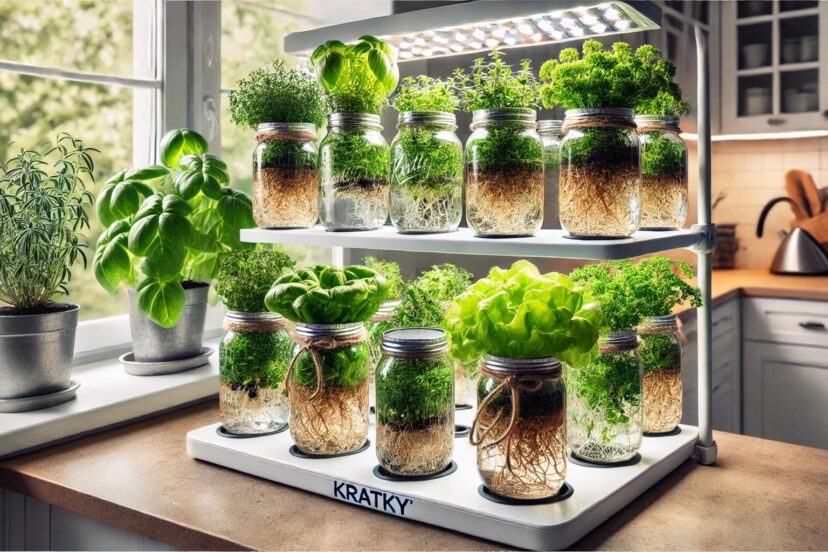
Different Types of Hydroponic Systems for Small Spaces
When it comes to hydroponics, there’s no one-size-fits-all approach. Here are a few beginner-friendly systems to consider:
1. Kratky Method (The Set-It-and-Forget-It System)
The easiest system to start with—just place plants in a container of nutrient-rich water, and let nature do the rest. No pumps, no electricity, no fuss!
2. Deep Water Culture (DWC) (Great for Leafy Greens)
This method suspends plants in a water-filled container with an air pump to keep roots oxygenated. It’s ideal for fast-growing greens.
3. Nutrient Film Technique (NFT) (Perfect for Herbs)
A constant flow of nutrients runs over plant roots in a small tube. It requires a pump but is incredibly space-efficient.
4. Vertical Hydroponics (Maximizes Small Spaces)
If you’re short on room, a vertical hydroponic system stacks plants upwards, making the most of every inch of space.
Essential Supplies to Start Your Hydroponic Garden
Before you begin, gather these key items:
1. Compact Hydroponic Growing Kit
A small, all-in-one system designed for beginners. These kits typically include a water reservoir, net pots, and a built-in LED grow light, making them perfect for countertop gardening.
2. Nutrient Solution for Hydroponics
A balanced mix of essential minerals that replace soil nutrients. Look for liquid or powder solutions specifically formulated for hydroponic plants to ensure healthy growth.
3. Growing Medium (Soil Alternative)
Since hydroponics doesn’t use soil, you’ll need an alternative like clay pebbles, Rockwool, or coco coir to support plant roots while allowing oxygen and nutrients to flow.
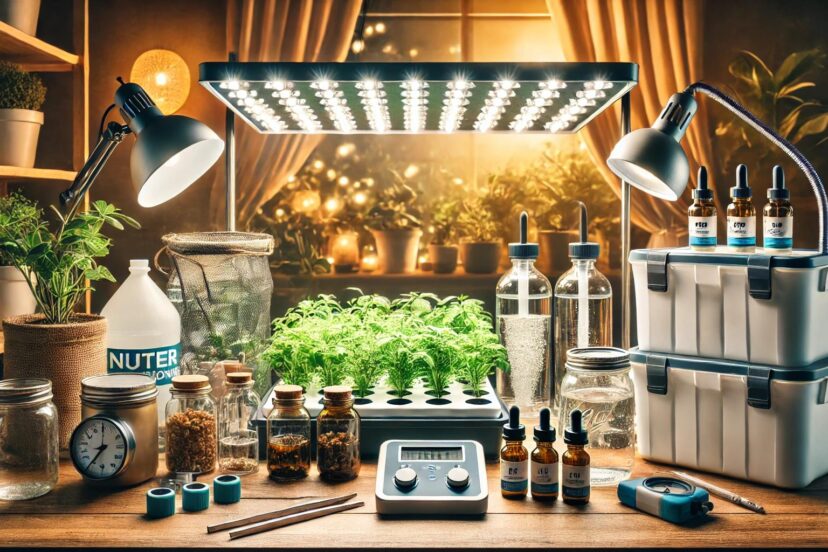
4. Net Pots & Small Containers
These small, mesh-like pots hold your plants while allowing roots to dangle into the water. Net pots are perfect for Kratky and DWC hydroponic system.
If natural sunlight is limited, full-spectrum LED grow lights help plants thrive indoors. Choose energy-efficient models with adjustable brightness and timers.
Hydroponic plants require a specific pH range (5.5–6.5) to absorb nutrients effectively. A digital pH meter helps you monitor and adjust the water’s acidity levels.
These essential products will help you set up a thriving hydroponic garden in even the smallest apartment, bringing fresh, home-grown greens right into your kitchen! 🌱
Setting Up Your Hydroponic Garden in 5 Simple Steps
Starting a hydroponic garden doesn’t require an engineering degree. Here’s a simple guide:
1. Choose Your System – Pick a setup that fits your space and skill level—Kratky for ease, DWC for bigger yields, or vertical if you’re tight on room.
2. Find the Perfect Spot – A sunny window works well, but if that’s not an option, LED grow lights will be your best friend.
3. Prepare Your Nutrient Solution – Mix your hydroponic nutrients with water, following package instructions.
4. Set Up Your Plants – Start with seedlings or cuttings and place them in net pots with a growing medium.
5. Monitor and Maintain – Check water levels, pH, and nutrient concentration regularly. A little attention goes a long way!
Lighting: Do You Need a Grow Light?
Natural sunlight is wonderful, but it’s not always reliable—especially in small apartments. LED grow lights can bridge the gap, ensuring your plants get the full spectrum of light they need to flourish.
💡 Pro Tip: Set your lights on a timer for 12-16 hours per day to mimic natural sunlight.
Water & Nutrients: Keeping Your Plants Thriving
A hydroponic garden thrives on balance. Here’s what to keep in mind:
- Use hydroponic-specific nutrients.
- Check pH levels (ideal range: 5.5–6.5).
- Refresh the water every 2-3 weeks to prevent buildup.
With the right care, your plants will reward you with lush, vibrant growth.
How to Prevent Common Hydroponic Gardening Problems
Even in a world where you control every variable, things still have a way of going sideways. It’s like having the perfect dinner recipe, and then somehow the sauce burns. But don’t panic—your hydroponic garden is still salvageable. Here’s your guide to troubleshooting those pesky problems that pop up, no matter how green your thumb is.
❌ Yellowing Leaves? Check for nutrient imbalances.
❌ Algae Growth? Cover the reservoir to block light.
❌ Root Rot? Improve oxygenation with an air pump.
❌ Slow Growth? Ensure enough light and nutrients.
Can Hydroponics Be Organic?
You might think hydroponics and organic gardening are like oil and water—two things that just don’t mix. But here’s the twist: they can! While most hydroponic systems rely on synthetic fertilizers, you can absolutely use organic alternatives. Fish emulsion, seaweed, and compost tea can all be used to feed your plants, giving them the nutrients they crave without any synthetic additives. It’s like choosing to make your plants a healthy, homemade meal instead of ordering fast food.
Scientific Insights on Hydroponic Gardening in Small Spaces
Hydroponic gardening is gaining recognition for its efficiency and sustainability, particularly in urban settings. A review on hydroponics highlights its ability to regulate growth conditions, resulting in faster plant growth and higher yields compared to traditional soil-based farming. Similarly, research from the University of Minnesota Extension emphasizes hydroponics’ space-saving advantages, reduced water usage, and the potential for year-round cultivation, even in limited indoor spaces. These findings reinforce hydroponics as an ideal solution for small-apartment gardening.
Is Hydroponic Gardening Expensive?
Let’s clear the air: hydroponic gardening doesn’t have to burn a hole in your pocket. Sure, you can splurge on high-end systems, but you don’t need a fortune to get started. You can easily set up a basic system for under $50. Think of it as investing in a hobby that pays you back, as hydroponics can save you money in the long run. No more shelling out for overpriced lettuce at the grocery store—your garden becomes your own personal salad bar.
Final Thoughts
Absolutely! Hydroponic gardening is a fun, rewarding, and efficient way to bring fresh, homegrown produce into your life—without the need for a backyard. Whether you’re a seasoned gardener or a curious beginner, hydroponics lets you enjoy the magic of growing your own food in even the smallest of spaces. So why not take the plunge? Your future self—and your taste buds—will thank you. 🌱💚
FAQs
- Can I grow a hydroponic garden without electricity?
Yes! The Kratky method works without electricity—perfect for small spaces. - When is the best time to change the water in a hydroponic system?
Every 2-3 weeks to keep nutrients fresh and prevent algae. - Do hydroponic plants taste different from soil-grown plants?
Nope! Hydroponic plants often taste fresher due to direct nutrient access. - Is it possible to grow root veggies like potatoes or carrots hydroponically?
Not easily. Root veggies need more space and support than most systems can offer. - What’s the easiest plant to grow in a hydroponic garden?
Lettuce! It’s fast-growing, low-maintenance, and perfect for beginners.

